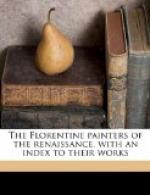[Page heading: BENOZZO GOZZOLI]
Benozzo was gifted with a rare facility not only of execution but of invention, with a spontaneity, a freshness, a liveliness in telling a story that wake the child in us, and the lover of the fairy tale. Later in life, his more precious gifts deserted him, but who wants to resist the fascination of his early works, painted, as they seem, by a Fra Angelico who had forgotten heaven and become enamoured of the earth and the spring-time? In his Riccardi Palace frescoes, he has sunk already to portraying the Florentine apprentice’s dream of a holiday in the country on St. John’s Day; but what a naif ideal of luxury and splendour it is! With these, the glamour in which he saw the world began to fade away from him, and in his Pisan frescoes we have, it is true, many a quaint bit of genre (superior to Teniers only because of superior associations), but never again the fairy tale. And as the better recedes, it is replaced by the worse, by the bane of all genre painting, non-significant detail, and positive bad taste. Have London or New York or Berlin worse to show us than the jumble of buildings in his ideal of a great city, his picture of Babylon? It may be said he here continues mediaeval tradition, which is quite true, but this very fact indicates his real place, which, in spite of his adopting so many of the fifteenth-century improvements, is not with the artists of the Renaissance, but with the story-tellers and costumed fairy-tale painters of the transition, with Spinello Aretino and Gentile da Fabriano, for instance. And yet, once in a while, he renders a head with such character, or a movement with such ease that we wonder whether he had not in him, after all, the making of a real artist.
[Page heading: GHIRLANDAIO]
Ghirlandaio was born to far more science and cunning in painting than was current in Benozzo’s early years, and all that industry, all that love of his occupation, all that talent even, can do for a man, they did for him; but unfortunately he had not a spark of genius. He appreciated Masaccio’s tactile values, Pollaiuolo’s movement, Verrocchio’s effects of light, and succeeded in so sugaring down what he adopted from these great masters that the superior philistine of Florence could say: “There now is a man who knows as much as any of the great men, but can give me something that I can really enjoy!” Bright colour, pretty faces, good likenesses, and the obvious everywhere—attractive and delightful, it must be granted, but, except in certain single figures, never significant. Let us glance a moment at his famous frescoes in Santa Maria Novella. To begin with, they are so undecorative that, in spite of the tone and surface imparted to them by four centuries, they still suggest so many tableaux vivants pushed into the wall side by side, and in tiers. Then the compositions are as overfilled as the sheets of an illustrated newspaper—witness the




